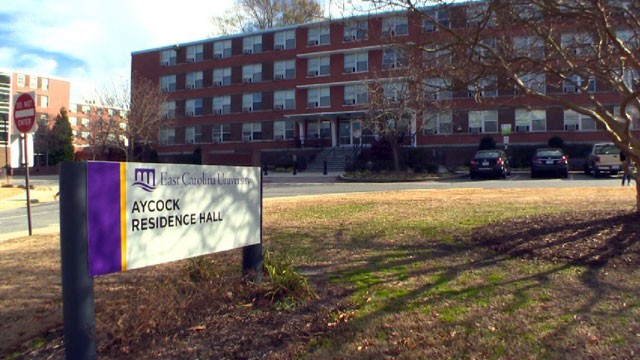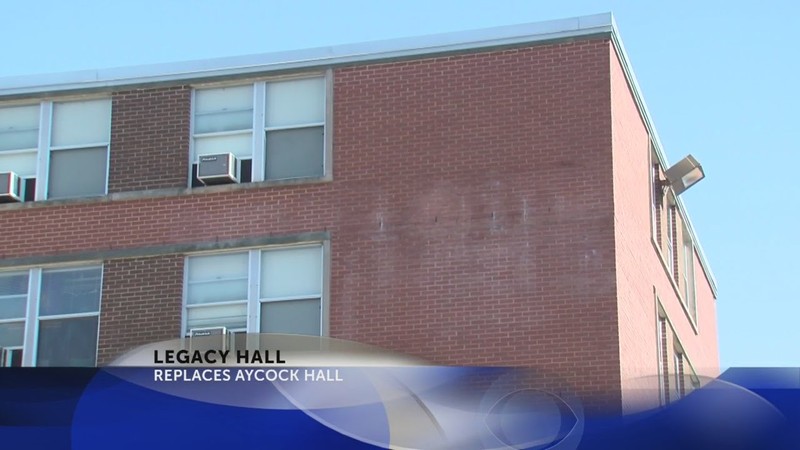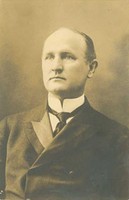Legacy Hall
Introduction
Text-to-speech Audio
Images
Aycock Hall before it was renamed.

The removal of Aycock's name from the dormitory

Charles B Aycock

Backstory and Context
Text-to-speech Audio
Charles B Aycock was born on November 1, 1859 in rural Wayne County. His parents, Benjamin Aycock and Serena Hooks, "were industrious, thrifty, and pious, and both had a good sense of management."2 In 1840, they built a house on 50 acres, and by 1960 the Aycock family had accumulated 1,036 acres of land and owned thirteen slaves. Benjamin Aycock was an active member of the Democratic party. He served as Wayne County's Clerk of Court and then went on to serve as a member of the North Carolina Senate from 1863 to 1866. Benjamin Aycock's support of the Confederacy and racial views shaped Charles B Aycock's own political views.3
During his youth, Charles B Aycock attended the Wilson Collegiate Institute and the Joseph H. Foy School in Kinston. After teaching for a year in Fremont, he was accepted to the University of North Carolina. After attending UNC, he studied at the University Normal School where he became enthusiastic about universal education. In 1881, Charles B Aycock was licensed to practice law and joined Frank Arthur Daniels as a law partner in Goldsboro, North Carolina. In the years of his law practice, Aycock became active in the Democratic party. He assisted in the foundation of the pro-Democratic newspaper, the Goldsboro Daily Argus, in 1885. Charles B Aycock became a fixture at Democratic party rallies. He served as an elector for Grover Cleveland, and in 1892, Aycock was nominated as Presidential elector at large. Because of his work for Cleveland, Charles B Aycock was appointed as U.S. District Attorney for eastern North Carolina from 1893 to 1897.3 During the 1890s Charles B Aycock and his firm partner Arthur Daniels joined in the fight against the interracial "Fusion Movement". Fusionists would campaign on free public schools for all and equal political rights for all men. "Conservatives created a one-party state under what Daniels called “permanent good government by the party of the White Man.”" Through this Aycock, along with other conservatives, built the social order of segregation that prevailed until the civil rights movement ended it in the 1960s.4
In 1900, Charles B Aycock was elected as governor of North Carolina. Throughout his whole campaign and term he stressed the importance of education. During his first year in office, Aycock spoke at local rallies in behalf of school taxes and bonds. He went on to make pleas for educational progress. Charles B Aycock helped form the Association for the Promotion of Public Education in North Carolina. "Under Aycock's leadership, the appropriations for the public schools and the state's colleges were increased, teaching standards were raised, state adoption of textbooks replaced the more expensive system of local adoption, 877 libraries were established in rural schools, and hundreds of schoolhouses were built."5 The enrollment of white children rose eleven percent, while the enrollment of Black children rose ten percent.6 In 1901, two proposed state constitutional amendments would have allowed whites to use taxes to improve only white schools. When Aycock threatened to resign if they were passed, neither bill ever came to a vote.7 After his term as governor, Charles B Aycock returned to his law practice in Goldsboro. In 1911, he became a candidate for the Democratic nomination to the U.S. Senate. On April 4, 1912 he died while campaigning. The last word Charles B. Aycock uttered as he died on a political rally podium was "education". This was a fitting last word for a man who improved education for all North Carolinians.8
Sources
2 Joseph F. Steelman, Aycock, Charles Brantley, American National Biography Online, Feb , 2000, http://www.ecu.edu/cs-studentaffairs/aycock/Bio.cfm, (accessed Oct 20, 2014).
3 Orr, NCpedia Aycock, (accessed Nov 6, 2016).
4 Tim Tyson, Raleigh News & Observer, Gov. Aycock and the tug-of-war over NC history, . Mar 13, 2015, http://www.newsobserver.com/opinion/op-ed/article14060240.html., (accessed Nov 21, 2016).
5 Orr, NCpedia Aycock, (accessed Nov 6, 2016).
6 Ibid.
7 Ibid.
8 Ibid.
